Brain Implant Enables Artificial Vision for Blind Woman

Researchers at University Miguel Hernández, Netherlands Institute of Neuroscience, and University of Utah (USA), have enabled a blind woman to see with a form of artificial vision based on a brain implant. This represents a leap forward for scientists hoping to create a visual brain prosthesis to increase independence of the blind.
A long-held dream of scientists is to transfer information directly to the visual cortex of blind individuals, thereby restoring a rudimentary form of sight. However, no clinically available cortical visual prosthesis yet exists. "This work is likely to become a milestone for the development of new technologies that could transform the treatment of blindness," said researcher P. Roelfsema.
A study is published in Journal of Clinical Investigation. It describes how an array of penetrating electrodes produced a simple form of vision for a 58-year-old blind volunteer.
"These results are very exciting because they demonstrate both safety and efficacy and could help to achieve a long-held dream of many scientists, which is the transfer information from the outside world directly to the visual cortex of blind individuals, thereby restoring a rudimentary form of sight," said researcher Eduardo Fernández.
The volunteer, a former science teacher, had been completely blind for 16 years at the time of the study. A microelectrode array composed of 100 microneedles was implanted into her visual cortex to both record from and stimulate neurons located close to the electrodes. She had no complications from the surgery, and researchers determined that the implant did not impair or negatively affect her brain function.
"One goal of this research is to give a blind person more mobility," said researcher R. A. Normann. "It could allow them to identify a person, doorways, or cars. It could increase independence and safety. That's what we're working toward."
The volunteer, who is a co-author of the paper, wore eyeglasses equipped with a miniature video camera. Specialized software encoded the visual data collected by the camera and sent it to the micro electrodes in the array located in her brain. The array then stimulated the surrounding neurons to produce white points of light known as “phosphenes” to create an image.
With the help of the implant, the volunteer was able to identify lines, shapes, and simple letters evoked by different patterns of stimulation.
Fernández cautioned that "although these preliminary results are very encouraging, we should be aware that there are still a number of important unanswered questions and that many problems have to be solved before a cortical visual prosthesis can be considered a viable clinical therapy."
Future research tests will use a more sophisticated image encoder system. It will be capable of stimulating more electrodes simultaneously to elicit more complex visual images.
More Articles
Don't miss a beat! In our Pulse Newsletter, Thrivous curates the most important news on health science and human enhancement, so you can stay informed without wasting time on hype and trivia. It's part of the free Thrivous newsletter. Subscribe now to receive email about human enhancement, nootropics, and geroprotectors, as well as company news and deals.
Read more articles at Thrivous, the human enhancement company. You can browse recent articles in Thrivous Views. See other Pulse Newsletter articles. Or check out an article below.
-
The Hannum Epigenetic Clock Measures Biomarkers of Aging
Epigenetic clocks, like the Horvath aging clock described in a previous post, capture aging processes at the molecular level. "It's ...
-
The Horvath Clock Measures Epigenetic Aging
Aging researcher and geneticist Steve Horvath is a professor at UC Los Angeles. He's known for developing the Horvath aging clock. The ...


